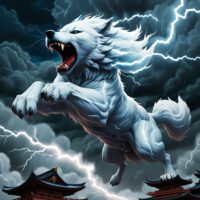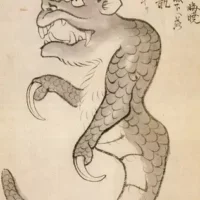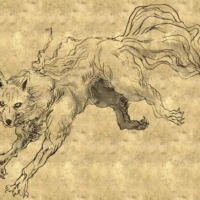Raiju : The Thunder Beast
Listen
At a glance
| Description | |
|---|---|
| Origin | Japanese Mythology |
| Classification | Animals |
| Family Members | N/A |
| Region | Japan |
| Associated With | Thunder, Lightning |
Raiju
Introduction
In Japanese mythology, few supernatural beings are as mysterious and electrifying as the Raiju, often translated as “thunder beast” or “thunder animal.” Deeply tied to storms and lightning, Raiju is both feared and admired, embodying the unpredictable power of nature. While its presence is often overshadowed by the god it accompanies—Raijin, the Shinto deity of thunder—the creature itself has carved out a distinct place in folklore. From Edo-period tales to modern pop culture, Raiju represents humanity’s fascination with thunder, lightning, and the untamed forces of the natural world.
Physical Traits
The physical description of Raiju is as fluid as the lightning it embodies. In most accounts, it appears as an animal enveloped in crackling electricity, often glowing white or pale blue against dark storm clouds. The form it takes varies from one region’s stories to another—it might be a wolf leaping through treetops, a fox darting across rooftops, or even a cat coiled in a ball of lightning. Some traditions describe Raiju as a squirrel or weasel with fur that bristles like sparks, while others imagine it as a strange chimera, blending features of several animals. Its claws are often emphasized, sharp enough to scar trees and buildings when lightning strikes. This ever-changing appearance reinforces its elemental essence, suggesting that Raiju is less a fixed creature and more a manifestation of storm energy itself.
Family
Raiju’s most important relationship in mythology is with Raijin, the Shinto god of thunder. Considered the beast’s master or companion, Raijin is often portrayed beating on drums to create thunder, while Raiju streaks alongside him in the sky. Together, they represent the violent spectacle of summer storms. In Shinto belief, Raijin is one of the eight thunder gods, often paired with Fūjin, the god of wind. This trinity of wind, thunder, and lightning forms the destructive yet life-giving forces that govern weather, harvests, and natural cycles. Through its bond with Raijin, Raiju is not merely an animal but a divine familiar, a creature that bridges the gap between human perception of storms and their spiritual explanations in Japanese cosmology.
Other names
The term Raiju (雷獣) itself directly translates to “thunder beast,” a simple yet evocative name. In some older texts and folklore collections, alternate romanizations like Raijuu are used, but they refer to the same creature. While Raiju itself does not carry a long list of alternative names, it is closely tied to Raijin, who is sometimes called the “Thunder King” or “God of Storms” in English translations. In modern contexts, Raiju is occasionally referred to as a “thunder spirit” or “lightning demon,” particularly in Western retellings. These names, while not traditional, show how the creature continues to be reinterpreted across cultures.
Powers and Abilities
As a being born of storms, Raiju’s powers naturally align with thunder and lightning. Legends claim it can leap great distances in flashes of light, often transforming into a glowing ball of energy that streaks across the sky. It is said to cause lightning strikes when landing on trees or buildings, leaving behind blackened scars attributed to its claws. Some tales describe Raiju hiding in human navels during thunderstorms, prompting Raijin to hurl lightning bolts in an attempt to retrieve it—a superstition that gave rise to the custom of covering one’s stomach while sleeping during storms. Beyond this peculiar habit, Raiju is thought to control weather, summon storms, and unleash destructive electric energy. Its dual nature—sometimes calm and harmless, other times frenzied and destructive—mirrors the unpredictable behavior of thunderstorms themselves.
Modern Day Influence
Although Raiju’s roots lie in ancient folklore, its influence continues to ripple through modern culture. In popular media, the creature has inspired characters and motifs across anime, manga, and video games. Perhaps the most famous reference is Raichu, the evolution of Pikachu in the Pokémon franchise, whose design and electric powers were directly influenced by Raiju myths. Literature has also embraced the creature, with novels like Raiju: A Kaiju Hunter Novel by K.H. Koehler reimagining it as a monstrous, battle-summoning beast. Even mobile and online games depict Raiju as a storm-summoning companion or lightning-tier creature.
Beyond entertainment, Raiju’s lore lingers in everyday customs. The old belief about covering one’s belly during storms is still remembered in Japan, a cultural echo of Raiju myths. During the Meiji era, so-called Raiju specimens—taxidermied animals passed off as thunder beasts—were exhibited in traveling shows, blending myth with pseudo-science. Scholars have even suggested that sightings of Raiju may have been inspired by real animals like the masked palm civet, whose nocturnal habits and sudden appearances during storms could have fueled the myth.
Related Images
Source
Foster, M. D. (2009). Pandemonium and parade: Japanese monsters and the culture of yōkai. University of California Press.
Komatsu, K. (1999). Yōkai no minzokugaku [Folklore of Yōkai]. Kadokawa Shoten.
Yoda, H., & Alt, M. (2013). Yokai Attack! The Japanese Monster Survival Guide. Tuttle Publishing.
Raijū. (n.d.). In Wikipedia. Retrieved August 22, 2025, from Raijū – Wikipedia
Raijū. (n.d.). In Yokai.com. Retrieved August 22, 2025, from Raijū | Yokai.com
Raijū. (n.d.). In World Mythos. Retrieved August 22, 2025, from Raiju – World Mythos
Raijū. (n.d.). In Horror Chronicles. Retrieved August 22, 2025, from Raiju: The Thunder Beast of Japanese Mythology – Horror Chronicles
Raijū. (n.d.). In Mythical Encyclopedia. Retrieved August 22, 2025, from Raiju: The Mythical Creature of Japanese Folklore
Frequently Asked Questions
What is lorem Ipsum?
I am text block. Click edit button to change this text. Lorem ipsum dolor sit amet, consectetur adipiscing elit. Ut elit tellus, luctus nec ullamcorper mattis, pulvinar dapibus leo.
What is lorem Ipsum?
I am text block. Click edit button to change this text. Lorem ipsum dolor sit amet, consectetur adipiscing elit. Ut elit tellus, luctus nec ullamcorper mattis, pulvinar dapibus leo.
What is lorem Ipsum?
I am text block. Click edit button to change this text. Lorem ipsum dolor sit amet, consectetur adipiscing elit. Ut elit tellus, luctus nec ullamcorper mattis, pulvinar dapibus leo.
What is lorem Ipsum?
I am text block. Click edit button to change this text. Lorem ipsum dolor sit amet, consectetur adipiscing elit. Ut elit tellus, luctus nec ullamcorper mattis, pulvinar dapibus leo.
What is lorem Ipsum?
I am text block. Click edit button to change this text. Lorem ipsum dolor sit amet, consectetur adipiscing elit. Ut elit tellus, luctus nec ullamcorper mattis, pulvinar dapibus leo.










